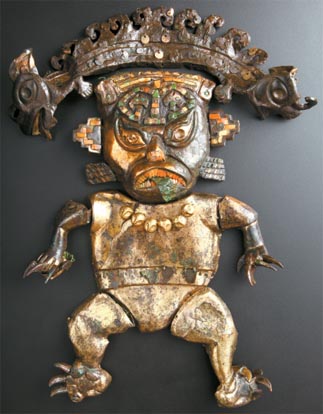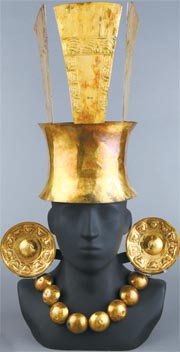Precious relics of an ancient civilization

Feline Figure, Moche period (100-700) Gilt bronze, gold, spondylus shell, turquoise
The exhibition “The Great Myth and Mystery of Peruvian Civilization: Inca,” which began Friday at the National Museum of Korea in Seoul, provides a glimpse into this lost culture by showcasing the Inca Empire’s development from over 20 ancient Andean civilizations. The exhibit also commemorates the 100th anniversary of the museum as well as the 20th anniversary of Korea-Peru bilateral cultural relations.

Crown and ornaments, Chimu period (1300-1470) Gold, silver and copper compound. Provided by the National Museum of Korea
The 351 artifacts on display - including mummies, jars, ornaments, weapons, textiles, ceramics and sculptures from nine museums in Peru - paint a portrait of the Inca Empire and the Inca civilization that preceded it. Some of the items on display show just how advanced the Inca were. Human skulls with holes show that the Inca used highly sophisticated medical techniques and were able to perform brain surgeries.
“People who had brain surgery continued to live after surgery,” said Choi Hyung-sun, assistant curator of the museum.
Choi also pointed out another feature of the exhibition - the mummies.
The oldest mummies in the world come from the Inca civilization, not from Egypt, Choi said.
The mummy in this exhibit is from the Chiribaya period (900-1440). The area has dry soil that contains a high amount of salt, which helped dry the body. Unlike Egyptian mummies, which are mummified in a supine position, the Inca mummified their dead in the seated position. Some mummies had their organs taken out and replaced by coca leaves or llama hairs. Often, animals were buried with their human counterparts. Two such animals, a mummified dog and a monkey, are displayed in this exhibit.
The exhibition is divided into three sections showing the Inca Empire; the civilizations that preceded the empire, including the Nazca, Moche and Chimu; and the ancient Andean culture and myths of the times.
One of the notable relics here is the sculpture of a “Feline Figure” produced in the Moche period (100-700). Made of gilt bronze, the piece was found in the pyramid of King Sipan. The crown is shaped like a snake and has a jaguar head on both ends. In the Andean civilizations, the bird, jaguar and snake symbolized the power of the sky, land and underground, respectively. Its menacing shape makes it quite intimidating.
Yet another piece of interest is the sacrificial knife, known as a tumi, from the Lambayeque period (750-1375). The tumi is a semi-circular knife that was used in sacrificial ceremonies. Blood from the sacrifice was then poured into a cup that was presented to the god.
The Inca Empire came to an end in 1532, and historians have speculated that there are several reasons for its demise: the Spanish invasion, long-standing tribal wars and a smallpox epidemic.
The empire was rich with gold but when the Spanish arrived and conquered the Inca, they took their gold artifacts as war trophies, melted them and shipped them to Europe. All of the golden artifacts in this exhibit are burial goods.
“The relics are significant because they not only show the lost culture [of the Inca] but also reveal something about the society of the civilization,” Marcela Lopez Bravo, Peruvian Ambassador to Korea, said in a press conference at the opening of the exhibit.
The exhibition continues through March 28, 2010. Hours are 9 a.m. to 6 p.m. on Tuesdays, Thursdays and Fridays; 9 a.m. to 9 pm. on Wednesdays and Saturdays; 9 a.m. to 7 p.m. on Sundays. Closed on Mondays. Admission costs 5,000 won ($4.30) to 10,000 won. Go to Ichon Station, line No. 4, exit 2. For more information, call 1588-7862 or visit www.museum.go.kr.
By Limb Jae-un [jbiz91@joongang.co.kr]










with the Korea JoongAng Daily
To write comments, please log in to one of the accounts.
Standards Board Policy (0/250자)